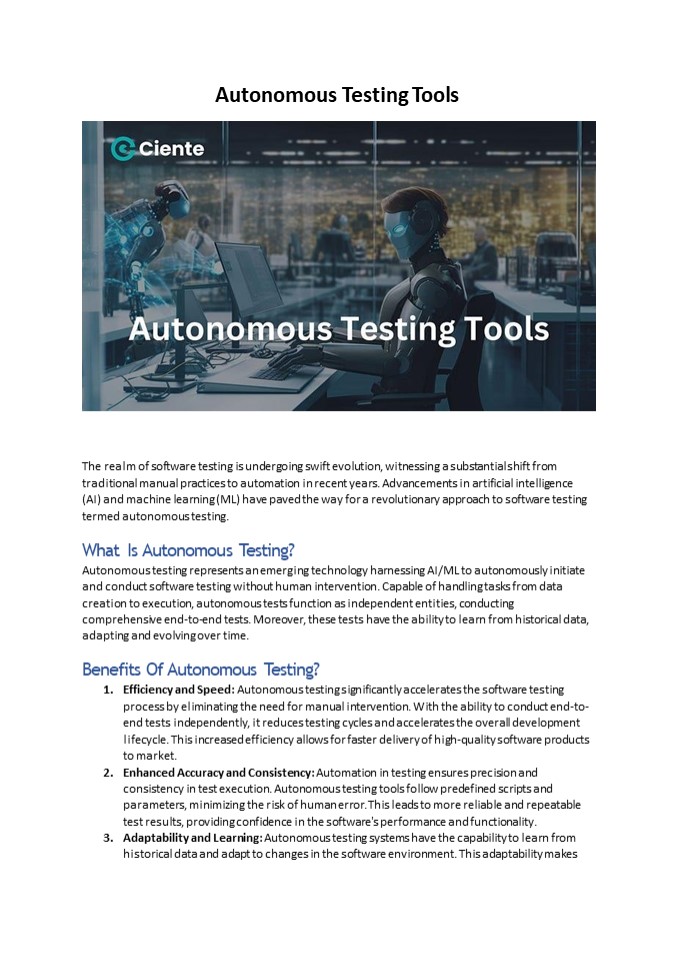Autonomous Testing Tools - PowerPoint PPT Presentation
Title:
Autonomous Testing Tools
Description:
The realm of software testing is undergoing swift evolution, witnessing a substantial shift from traditional manual practices to automation in recent years. Read this Article here: Learn more: Follow for more such Articles: – PowerPoint PPT presentation
Number of Views:0
Date added: 12 December 2023
Slides: 4
Provided by:
Team_ciente
Category:
Medicine, Science & Technology
Tags:
Title: Autonomous Testing Tools
1
Autonomous Testing Tools
- The realm of software testing is undergoing swift
evolution, witnessing a substantial shift from
traditional manual practices to automation in
recent years. Advancements in artificial
intelligence (AI) and machine learning (ML) have
paved the way for a revolutionary approach to
software testing termed autonomous testing. - What Is Autonomous Testing?
- Autonomous testing represents an emerging
technology harnessing AI/ML to autonomously
initiate and conduct software testing without
human intervention. Capable of handling tasks
from data - creation to execution, autonomous tests function
as independent entities, conducting - comprehensive end-to-end tests. Moreover, these
tests have the ability to learn from historical
data, adapting and evolving over time. - Benefits Of Autonomous Testing?
- Efficiency and Speed Autonomous testing
significantly accelerates the software testing
process by eliminating the need for manual
intervention. With the ability to conduct end-to-
end tests independently, it reduces testing
cycles and accelerates the overall development
lifecycle. This increased efficiency allows for
faster delivery of high-quality software products
to market. - Enhanced Accuracy and Consistency Automation in
testing ensures precision and - consistency in test execution. Autonomous testing
tools follow predefined scripts and parameters,
minimizing the risk of human error. This leads to
more reliable and repeatable test results,
providing confidence in the software's
performance and functionality. - Adaptability and Learning Autonomous testing
systems have the capability to learn from
historical data and adapt to changes in the
software environment. This adaptability makes
2
- them well-suited for dynamic and evolving
software projects. By continuously learning and
evolving, these systems enhance their
effectiveness over time, improving the overall - resilience and reliability of the testing
process. - Top 3 autonomous testing tools today
- Appvance Appvance's autonomous testing platform,
powered by AI, ensures comprehensive test
coverage, catering to both mobile and web
applications. It accommodates diverse - testing needs, including load, performance, and
security testing. The tool goes beyond by
automatically generating regression test scripts
based on real user flows and possesses a
self-healing capability, efficiently identifying
and rectifying bugs during testing. However, - given its sophisticated nature, mastering and
utilizing this testing tool may present a
learning curve. Additionally, for those on a
constrained budget, the pricing of Appvance can
be - relatively higher compared to other automated
testing tools. - Testim Testim stands out as an AI-driven UI and
functional platform designed for autonomous
testing of web applications and mobile
interfaces. Utilizing a code-free testing - approach, it empowers testers to build test cases
without coding expertise. The platform excels in
automatically identifying and prioritizing
crucial elements within the application,
adjusting test cases to accommodate modifications
seamlessly. Additionally, Testim - incorporates AI-powered stabilizers to minimize
test case instability. However, it's important
to note some limitations of this tool, including
a steeper learning curve, higher associated
costs, and limited customizability. - Mable Mable, an autonomous testing tool
utilizing AI and low-code techniques, caters to
UI, API, and performance testing. Its unique
feature includes automatic healing, enabling the - adaptation of test cases to changes in the
application. This functionality aims to decrease
the burden of test case maintenance and bolster
overall testing reliability. However, users have
reported drawbacks such as slower testing speeds
and limitations in supporting various software
testing types. - Conclusion
- Embarking on Autonomous Testing is a
forward-thinking and ambitious initiative set to
revolutionize the testing landscape. However,
navigating this transition can be intricate, with
the introduction of new terminologies, concepts,
and discussions. The adoption of Autonomous
Testing presents both benefits and challenges
that we must grapple with. - Nevertheless, the integration of AI into
automated testing tools to develop an
intelligent, self- adapting testing tool remains
a promising endeavor. This effort holds the
potential to empower QA teams to conduct more
effective and efficient testing.
3
AUTHOURS BIO With Ciente, business leaders stay
abreast of tech news and market insights that
help them level up now,
Technology spending is increasing, but so is
buyers remorse. We are here to change that.
Founded on truth, accuracy, and tech prowess,
Ciente is your go-to periodical for effective
decision-making.
Our comprehensive editorial coverage, market
analysis, and tech insights empower you to
make smarter decisions to fuel growth and
innovation across your enterprise.
Let us help you navigate the rapidly evolving
world of technology and turn it to your advantage.































